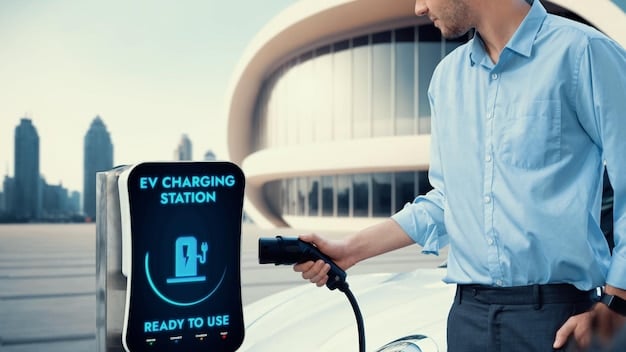Federal Fuel Efficiency Standards 2025: Automaker Implications

The key implications of the new federal fuel efficiency standards for automakers in 2025 involve significant investments in electric vehicle (EV) technology, potential shifts in production strategies, and adapting to evolving consumer preferences to avoid penalties and maintain competitiveness.
The automotive industry is on the cusp of a significant transformation as it braces for the key implications of the new federal fuel efficiency standards for automakers in 2025. These standards are poised to reshape vehicle design, production strategies, and the overall market landscape.
Understanding the 2025 Federal Fuel Efficiency Standards
The federal fuel efficiency standards, officially known as the Corporate Average Fuel Economy (CAFE) standards, are regulations set by the National Highway Traffic Safety Administration (NHTSA) to improve the average fuel economy of cars and light trucks produced for sale in the United States. Understanding these standards is crucial for grasping their impact on automakers.
These standards have been evolving over the years, becoming progressively stricter to promote energy conservation and reduce greenhouse gas emissions. The 2025 standards represent a significant leap forward, requiring automakers to achieve even higher fuel economy averages across their fleets.

Historical Context and Evolution
Since their inception in 1975, CAFE standards have played a pivotal role in shaping the automotive industry. The initial goals were to respond to the energy crisis and reduce dependence on foreign oil. Over the decades, these standards have been revised and strengthened, reflecting advancements in automotive technology and growing environmental concerns.
The Obama administration introduced more aggressive targets for the 2017-2025 period, aiming to nearly double fuel economy. While there were subsequent adjustments under the Trump administration, the current trajectory indicates a return to stricter standards, setting the stage for the 2025 requirements.
Key Provisions of the 2025 Standards
The 2025 standards mandate a significant increase in fuel efficiency, requiring automakers to achieve an average of approximately 54.5 miles per gallon (MPG) for cars and light trucks. Several mechanisms are in place to ensure compliance.
- Fleet Averaging: Automakers can meet the standards by averaging the fuel economy of all vehicles they sell, allowing them to offer a mix of fuel-efficient and less efficient models.
- Credit System: Companies can earn credits for exceeding the standards in a given year and use those credits to offset shortfalls in other years.
- Flexibility Measures: The regulations include some flexibility, such as credits for adopting advanced technologies like electric vehicles and plug-in hybrids.
In essence, the 2025 federal fuel efficiency standards are designed to push automakers towards producing more fuel-efficient vehicles, fostering innovation, and reducing the environmental impact of transportation.
Technological Investments and Shifts
Meeting the 2025 federal fuel efficiency standards requires substantial technological investments and strategic shifts in production. Automakers must explore various avenues to enhance fuel economy, driving innovation in engine design, vehicle lightweighting, and electrification.
These shifts are not merely about meeting regulatory requirements; they also represent an opportunity for automakers to gain a competitive edge in a rapidly evolving market.
Electric Vehicle (EV) Development
One of the most significant implications of the standards is the accelerated development and deployment of electric vehicles (EVs). EVs offer zero tailpipe emissions and contribute significantly to improving a manufacturer’s overall fuel economy average.
Automakers are investing billions of dollars in EV technology, including battery research, charging infrastructure development, and the design of new electric vehicle platforms. Tesla’s success has also set the tone.
Hybridization and Engine Optimization
Beyond EVs, automakers are also focusing on hybrid technologies and optimizing internal combustion engines. Hybrid vehicles combine an electric motor with a traditional engine, offering improved fuel economy and reduced emissions.
Advanced engine technologies, such as turbocharging, direct injection, and variable valve timing, are also being employed to maximize efficiency. These incremental improvements can collectively contribute to meeting the stringent fuel economy targets.
Lightweighting and Aerodynamics
Reducing vehicle weight is another critical strategy. Lighter vehicles require less energy to accelerate and maintain speed, resulting in improved fuel economy. Automakers are using lightweight materials like aluminum, carbon fiber, and high-strength steel to reduce the weight of their vehicles.
Improving aerodynamics is also essential. Streamlined designs reduce air resistance, further enhancing fuel efficiency. Techniques such as optimizing body shapes, adding aerodynamic aids, and reducing drag coefficients are becoming increasingly common.
Ultimately, the path to meeting the 2025 standards involves a multifaceted approach, combining advanced technologies, innovative materials, and optimized designs to create more fuel-efficient vehicles.
Production Strategy Adjustments
The new federal fuel efficiency standards are prompting automakers to re-evaluate their production strategies. This includes decisions about which types of vehicles to produce, where to produce them, and how to balance the mix of fuel-efficient and less efficient models.
These adjustments are not just about compliance; they also reflect a broader adaptation to changing consumer demands and market dynamics.
Shifting Production Mix
Automakers are likely to shift their production mix towards more fuel-efficient models to meet the CAFE standards. This could mean increasing production of EVs, hybrids, and smaller, more efficient cars, while reducing production of larger, less efficient vehicles like SUVs and trucks.
However, this presents a challenge, as SUVs and trucks remain popular among consumers and generate significant profits for automakers. Balancing the production mix to meet both regulatory requirements and consumer preferences is a delicate balancing act.
Global Production Strategies
Automakers with global production operations have more flexibility in meeting the standards. They can allocate production of fuel-efficient vehicles to the U.S. market while producing less efficient models in other regions with less stringent regulations.
This global approach allows automakers to optimize their production strategies on a worldwide scale, taking advantage of varying regulatory environments and market conditions.
Supply Chain Considerations
The shift towards EVs and advanced technologies also has implications for the supply chain. Automakers need to secure access to critical materials like lithium, cobalt, and nickel, which are essential for battery production. They also need to develop partnerships with suppliers of advanced engine components and lightweight materials.
- Ensuring a stable supply of these materials is crucial for scaling up EV production and meeting the demand for fuel-efficient vehicles.
- Supply chain disruptions, such as those caused by geopolitical tensions or natural disasters, could pose a significant challenge to automakers.
- Therefore, automakers are actively working to diversify their supply chains and secure long-term contracts with key suppliers.
In summary, adapting production strategies to meet the 2025 federal fuel efficiency standards involves careful planning, strategic decision-making, and a proactive approach to managing the supply chain.
Consumer Behavior and Market Impact
Changes in consumer behavior and the overall market impact are critical considerations. The success of the new standards hinges on consumers’ willingness to adopt fuel-efficient vehicles and adapt to the changing automotive landscape.
Understanding these dynamics is essential for automakers to make informed decisions about product development, marketing strategies, and pricing.
EV Adoption Rates
The rate at which consumers adopt EVs will significantly influence the market impact of the new standards. Factors such as purchase price, range anxiety, charging infrastructure availability, and government incentives all play a role in EV adoption rates.
If EV adoption rates remain low, automakers may struggle to meet the CAFE standards without significantly altering their production mix or incurring penalties. On the other hand, rapid EV adoption could accelerate the transition to a more sustainable transportation system.
Impact on Vehicle Pricing
The cost of compliance with the 2025 standards could impact vehicle pricing. Automakers may need to invest in advanced technologies and materials, which could increase the cost of new vehicles. This could make fuel-efficient vehicles less affordable for some consumers, potentially slowing down adoption rates.
However, government incentives, such as tax credits and rebates, can help offset these costs and make fuel-efficient vehicles more attractive to consumers. Automakers may also find ways to absorb some of the costs through economies of scale and improved manufacturing processes.

Shifting Consumer Preferences
Consumer preferences are constantly evolving, and automakers need to stay ahead of these trends to remain competitive. As awareness of environmental issues grows, more consumers are likely to prioritize fuel efficiency and sustainability when purchasing a vehicle.
- Automakers that can offer a range of fuel-efficient vehicles that meet consumer needs and preferences will be well-positioned to succeed in the changing market.
- Marketing strategies that highlight the benefits of fuel-efficient vehicles, such as lower operating costs and reduced environmental impact, can help influence consumer behavior.
- Ultimately, the market impact of the new standards will depend on how well automakers can align their product offerings with evolving consumer preferences.
Consumer behavior is not static; it is influenced by market conditions, technological advancements, and societal trends. Automakers that can anticipate and adapt to these changes will be best equipped to thrive in the era of stricter fuel efficiency standards.
Potential Penalties and Compliance Strategies
Failing to meet the 2025 federal fuel efficiency standards can result in significant penalties for automakers. Understanding these penalties and developing effective compliance strategies is crucial for minimizing financial risks and maintaining competitiveness.
These strategies involve a combination of technological innovation, production adjustments, and proactive engagement with regulatory bodies.
Financial Penalties for Non-Compliance
Automakers that fail to meet the CAFE standards are subject to financial penalties. The penalty is typically assessed per vehicle and is based on the amount by which the automaker’s fleet average falls short of the required standard.
These penalties can be substantial, potentially costing automakers millions or even billions of dollars per year. The financial burden of non-compliance underscores the importance of meeting the standards.
Compliance Strategies
Automakers employ a variety of strategies to ensure compliance with the CAFE standards. These strategies can be broadly categorized into technological measures, production adjustments, and regulatory engagement.
Technological measures include investing in EV development, optimizing internal combustion engines, reducing vehicle weight, and improving aerodynamics. Production adjustments involve shifting the production mix towards more fuel-efficient models and optimizing global production strategies.
Working with Regulatory Bodies
Engaging with regulatory bodies like the NHTSA and the EPA is also an important part of the compliance strategy. Automakers can provide feedback on proposed regulations, seek clarification on compliance requirements, and advocate for policies that support the transition to a more sustainable transportation system.
The CAFE standards also include provisions for earning credits for exceeding the standards in a given year and using those credits to offset shortfalls in other years. This encourages automakers to go above and beyond the minimum requirements and provides flexibility in meeting the standards. By engaging with regulatory bodies, automakers can help shape future regulations and ensure a level playing field for all industry participants.
Ultimately, compliance with the 2025 federal fuel efficiency standards requires a comprehensive and proactive approach. Automakers that can effectively manage these challenges will be well-positioned for sustained success in the evolving automotive industry.
Long-Term Impacts on the Auto Industry
The long-term impacts extend far beyond the immediate concerns of meeting regulatory requirements. These standards are poised to drive fundamental changes in the auto industry, shaping its future direction and competitive landscape.
These changes include the rise of electrification, the emergence of new business models, and the transformation of the automotive workforce.
The Rise of Electrification
These standards are accelerating the shift towards electric vehicles, transforming the automotive landscape. As EVs become more prevalent, the traditional internal combustion engine will gradually be phased out, leading to a new era of electric mobility.
This transition has profound implications for automakers, suppliers, and the entire transportation ecosystem. Companies that can successfully navigate this transition will be well-positioned to lead the industry in the future.
New Business Models
The shift towards EVs is also fostering the emergence of new business models in the auto industry. These models include subscription services, mobility-as-a-service platforms, and energy storage solutions.
Automakers are exploring these new business models as a way to diversify their revenue streams and adapt to changing consumer preferences. These new models are not only about selling cars; they are about providing mobility solutions that meet the evolving needs of consumers.
| Key Point | Brief Description |
|---|---|
| ⚡ EV Investments | Automakers must invest heavily in electric vehicle technology. |
| ⚙️ Production Shifts | Adjust production toward more fuel-efficient models. |
| 💰 Potential Penalties | Non-compliance leads to significant financial penalties. |
| 📊 Market Impact | Consumer adoption rates and pricing will be affected. |
FAQ
▼
CAFE standards are the Corporate Average Fuel Economy regulations in the U.S., designed to increase the fuel efficiency of vehicles sold domestically, lowering energy consumption and emissions.
▼
The 2025 standards require automakers to significantly increase the fuel economy of their fleets, necessitating investments in new technologies and adjustments to production strategies.
▼
Electric vehicles (EVs), hybrids, advanced engine designs, lightweight materials, and aerodynamic improvements are key technologies for meeting the stringent 2025 standards.
▼
Automakers that fail to meet the CAFE standards face significant financial penalties, which are calculated based on the extent of their non-compliance and the number of vehicles sold.
▼
Consumers may see a wider variety of fuel-efficient vehicles, potentially higher initial vehicle costs, and the possibility of government incentives to offset the increased price of advanced technologies.
Conclusion
The key implications of the new federal fuel efficiency standards for automakers in 2025 are profound, requiring significant technological investments, production strategy adjustments, and adaptation to evolving consumer preferences. As the industry navigates these changes, success will hinge on innovation, strategic planning, and a commitment to sustainable transportation solutions.





